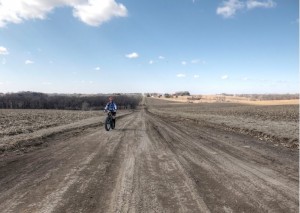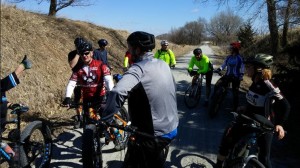If you were out enjoying the warm temperatures this weekend on your bikes, you know what I’m talking about. Today saw wind speeds in the 20s with gusts of nearly 40 mph, and yesterday was not far behind. I know because I was riding in it, looking forward to changing direction and not having a headwind anymore, but the wind shifted so I got to ride into it from two directions.

Today was worse, the angled crosswind actually shoving our bikes sideways across the gravel. It’s not quite so unstable to ride on a hard surface, and city riding is more protected, but what can you do to feel less likely to be blown over? Keep these things in mind:
If you can avoid using a back pack and thereby turning yourself into a sail, that will help. Keep your center of gravity low by using panniers.
If you are in traffic, realize that a gust or the passing of a truck could make you veer. Anticipate this and stay loose, don’t lock your elbows.
Stay low and make yourself small. Tuck yourself in to avoid as much wind resistance as possible.
Clothing should not be catching the wind either, so avoid unzipping jackets and letting clothing flap or billow like a parachute. Do wear eye protection. The wind really dries out your eyes, so some with sensitive eyes may even need eye drops.
There is a saying “spin into the wind.” Gear down a little so you don’t expend too much energy fighting it. Others however, think you lose too much momentum that way. It may depend on how long you’re riding.
Downhills can make you feel even more unstable, so try a higher gear and pedal rather than coasting. Even a little power to the rear wheel helps with stability, as does shifting your weight into your feet, just stay low and don’t stand up.
If you’re commuting you probably can’t change your route or ride departure time too much. If you’re going out for a dedicated ride, you can try riding into the wind when you head out so as to have a tailwind for the ride home, provided it doesn’t shift or die on you. If possible choose a sheltered route, with trees or hills to break the wind.
Generally speaking winds are lighter earlier in the morning, and die down around sunset for the most part. Consulting the projected wind directions when planning your ride can make a big difference.

A stop for refueling and rest can certainly improve the quality of the ride, especially for those without as much experience. You may find that you’re working twice as hard to go the same distance, and that it took twice as long.
This is Nebraska however, and windy riding is something to expect. It doesn’t have to be a bad thing. Adjust the time allowed for the ride if needed, and chalk it up to an opportunity to get extra resistance training. The wind is the closest thing to having mountains we have.
